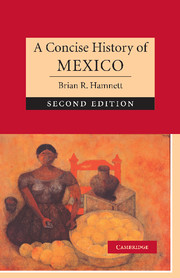Book contents
- Frontmatter
- Contents
- List of illustrations
- Chronology
- Preface to the second edition
- Preface to the first edition
- 1 Mexico in perspective
- 2 The pre-Columbian era
- 3 The European incursion, 1519–1620
- 4 New Spain, 1620–1770: Spanish colonialism and American society
- 5 Destabilisation and fragmentation, 1770–1867
- 6 Reconstruction, 1867–1940
- 7 The monopoly party, 1940–2000
- 8 The Fox administration, 2000–2006
- 9 Cultural developments since Independence
- Final comments
- Bibliography
- Index
- Titles in the series
3 - The European incursion, 1519–1620
Published online by Cambridge University Press: 05 June 2014
- Frontmatter
- Contents
- List of illustrations
- Chronology
- Preface to the second edition
- Preface to the first edition
- 1 Mexico in perspective
- 2 The pre-Columbian era
- 3 The European incursion, 1519–1620
- 4 New Spain, 1620–1770: Spanish colonialism and American society
- 5 Destabilisation and fragmentation, 1770–1867
- 6 Reconstruction, 1867–1940
- 7 The monopoly party, 1940–2000
- 8 The Fox administration, 2000–2006
- 9 Cultural developments since Independence
- Final comments
- Bibliography
- Index
- Titles in the series
Summary
Aztec hegemony in central and southern Mexico during the fifteenth century had already accustomed the population to subordination, assimilation, and strategies of survival. The modern dominance of the central valley originated in the pre-Columbian era. Indian opponents of the Aztecs allied with the Spanish conquerors, in order to bring down Tenochtitlán. For a time, they made use of the fortuitous arrival of the strangers in the internal power struggle within Mesoamerica. In such a way, they believed they could restore a world freed of Aztec domination. Spanish objectives and methods, however, ensured that the real beneficiaries of the destruction of Tenochtitlán were not the Indians themselves, and that the post-Conquest era would not be one of revindication but one of deepening servitude. The Spaniards intended to put themselves into the position held by the Aztec elite and rule their conquered territory in a substantially similar manner, though on a different religious basis. They could not themselves foresee the dramatic impact of the Conquest over the subsequent decades.
The Spanish who arrived in Mesoamerica had passed through two previous conquests beforehand, those of the Muslim Kingdom of Granada and the Caribbean islands, both from 1492. Although scarcely knowing what they would find on the American mainland, they arrived with a set of assumptions about conquered territories of different religions. They came at an epoch of proven Castilian military prowess demonstrated in the Italian campaigns of the ‘Gran Capitán’ Gonzalo Fernández de Córdoba against the French during the 1490s and 1500s.
- Type
- Chapter
- Information
- A Concise History of Mexico , pp. 58 - 79Publisher: Cambridge University PressPrint publication year: 2006

